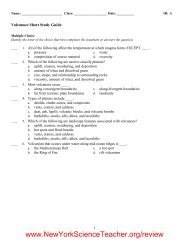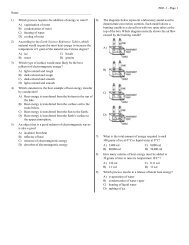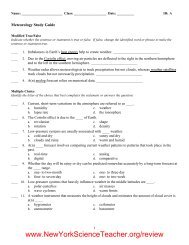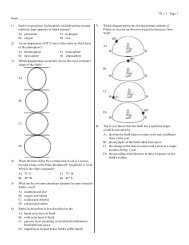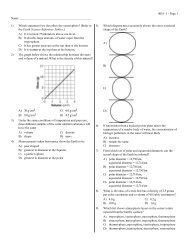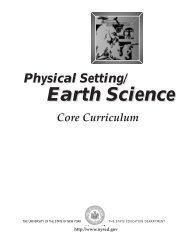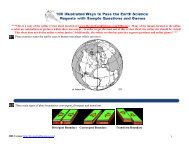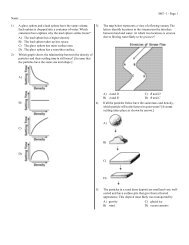temperature changes during 1 year in New York - Earth Science Review
temperature changes during 1 year in New York - Earth Science Review
temperature changes during 1 year in New York - Earth Science Review
You also want an ePaper? Increase the reach of your titles
YUMPU automatically turns print PDFs into web optimized ePapers that Google loves.
Name: ____________________________________________<br />
1) What is the primary reason <strong>New</strong> <strong>York</strong> State is warmer <strong>in</strong> July<br />
than <strong>in</strong> February?<br />
A) The altitude of the noon Sun is greater <strong>in</strong> February.<br />
B) The <strong>in</strong>solation <strong>in</strong> <strong>New</strong> <strong>York</strong> is greater <strong>in</strong> July.<br />
C) The <strong>Earth</strong> is closer to the Sun <strong>in</strong> July.<br />
D) The <strong>Earth</strong> is travel<strong>in</strong>g faster <strong>in</strong> its orbit <strong>in</strong> February.<br />
2) The factor that contributes most to the seasonal<br />
<strong>temperature</strong> <strong>changes</strong> <strong>dur<strong>in</strong>g</strong> 1 <strong>year</strong> <strong>in</strong> <strong>New</strong> <strong>York</strong> State is the<br />
chang<strong>in</strong>g<br />
A) distance between the <strong>Earth</strong> and the Sun<br />
B) angle at which the Sun's rays strike the <strong>Earth</strong>'s surface<br />
C) speed at which the <strong>Earth</strong> travels <strong>in</strong> its orbit around the<br />
Sun<br />
D) energy given off by the Sun<br />
3) Most of the energy <strong>in</strong> the <strong>Earth</strong>'s atmosphere comes from<br />
A) the rotation of the <strong>Earth</strong> and w<strong>in</strong>d from the <strong>Earth</strong><br />
B) the rotation and revolution of the <strong>Earth</strong><br />
C) radioactive decay of elements and radiation from the<br />
<strong>Earth</strong><br />
D) radiation from the <strong>Earth</strong> and <strong>in</strong>solation from the Sun<br />
4) What happens to the angle of <strong>in</strong>solation on June 21<br />
between solar noon and 6 p.m. <strong>in</strong> <strong>New</strong> <strong>York</strong> State?<br />
A) It <strong>in</strong>creases steadily.<br />
B) It rema<strong>in</strong>s the same.<br />
C) It first <strong>in</strong>creases and then decreases.<br />
D) It decreases steadily.<br />
5) If dust particles are added to the atmosphere, the amount of<br />
<strong>in</strong>solation reach<strong>in</strong>g the ground will probably<br />
A) <strong>in</strong>crease<br />
B) rema<strong>in</strong> the same<br />
C) decrease<br />
6) On which date does the maximum duration of <strong>in</strong>solation<br />
occur <strong>in</strong> the Northern Hemisphere?<br />
A) June 21<br />
B) December 21<br />
C) March 21<br />
D) September 23<br />
7) As the amount of reflection caused by dust particles <strong>in</strong> the<br />
atmosphere <strong>in</strong>creases, the amount of <strong>in</strong>solation reach<strong>in</strong>g the<br />
<strong>Earth</strong>'s surface<br />
A) <strong>in</strong>creases<br />
B) decreases<br />
C) rema<strong>in</strong>s the same<br />
8) In the diagram below, a vertical post casts shadows A, B, C,<br />
and D at four different times <strong>dur<strong>in</strong>g</strong> the day. Which shadow<br />
was cast when this location was receiv<strong>in</strong>g the greatest<br />
<strong>in</strong>tensity of <strong>in</strong>solation?<br />
A) shadow C<br />
B) shadow B<br />
C) shadow A<br />
D) shadow D<br />
4364 - 1 - Page 1<br />
9) At which latitude would the duration of <strong>in</strong>solation be<br />
greatest on December 21?<br />
A) 23\D N.<br />
C) 0D<br />
B) 23\D S.<br />
D) 10D N.<br />
10) Which two factors determ<strong>in</strong>e the number of hours of<br />
daylight at a particular location?<br />
A) longitude and the <strong>Earth</strong>'s average diameter<br />
B) longitude and season<br />
C) latitude and the <strong>Earth</strong>'s average diameter<br />
D) latitude and season<br />
11) The seasonal <strong>temperature</strong> <strong>changes</strong> <strong>in</strong> the climate of <strong>New</strong><br />
<strong>York</strong> State are <strong>in</strong>fluenced mostly by the<br />
A) chang<strong>in</strong>g speed at which the <strong>Earth</strong> travels <strong>in</strong> its orbit<br />
around the Sun<br />
B) chang<strong>in</strong>g angle at which the Sun's rays strike the<br />
<strong>Earth</strong>'s surface<br />
C) rotation of the <strong>Earth</strong> on its axis<br />
D) chang<strong>in</strong>g distance of the <strong>Earth</strong> from the Sun
12) Which graph below best represents the relationship<br />
between the angle of <strong>in</strong>solation and the <strong>in</strong>tensity of<br />
<strong>in</strong>solation?<br />
A)<br />
B)<br />
C)<br />
D)<br />
13) In which diagram does the <strong>in</strong>com<strong>in</strong>g solar radiation reach<strong>in</strong>g<br />
the <strong>Earth</strong>'s surface have the greatest <strong>in</strong>tensity?<br />
A)<br />
B)<br />
C)<br />
D)<br />
14) Dur<strong>in</strong>g which month does the m<strong>in</strong>imum duration of<br />
<strong>in</strong>solation occur <strong>in</strong> <strong>New</strong> <strong>York</strong> State?<br />
A) February<br />
B) December<br />
C) September<br />
D) July<br />
15) Over a period of one <strong>year</strong>, which location would probably<br />
have the greatest average <strong>in</strong>tensity of <strong>in</strong>solation per unit<br />
area? [Assume equal atmospheric transparency at each<br />
location.]<br />
A) <strong>New</strong> <strong>York</strong> City (41D N)<br />
B) Tropic of Cancer (23\D N)<br />
C) the North Pole (90D N)<br />
D) the Arctic Circle (66\D N)<br />
16) In <strong>New</strong> <strong>York</strong> State, the longest period of <strong>in</strong>solation occurs<br />
on or about<br />
A) June 21<br />
B) March 21<br />
C) August 21<br />
D) January 21<br />
17) Which statement best describes how the <strong>in</strong>solation <strong>changes</strong><br />
<strong>in</strong> <strong>New</strong> <strong>York</strong> State from May 21 through June 21?<br />
A) The <strong>in</strong>tensity and the duration of <strong>in</strong>solation both<br />
decrease.<br />
B) The <strong>in</strong>tensity of <strong>in</strong>solation decreases and the duration<br />
of <strong>in</strong>solation <strong>in</strong>creases.<br />
C) The <strong>in</strong>tensity and the duration of <strong>in</strong>solation both<br />
<strong>in</strong>crease.<br />
D) The <strong>in</strong>tensity of <strong>in</strong>solation <strong>in</strong>creases and the duration<br />
of <strong>in</strong>solation decreases.<br />
18) Electromagnetic energy that reaches the <strong>Earth</strong> from the Sun<br />
is called<br />
A) <strong>in</strong>solation<br />
B) conduction<br />
4364 - 1 - Page 2<br />
C) terrestrial radiation<br />
D) specific heat
Questions 19 and 20 refer to the follow<strong>in</strong>g:<br />
The diagrams below show the general effect of the <strong>Earth</strong>'s atmosphere on <strong>in</strong>solation from the Sun at middle latitudes <strong>dur<strong>in</strong>g</strong> both clearsky<br />
and cloudy-sky conditions. The graph below shows the percentage of <strong>in</strong>solation reflected by the <strong>Earth</strong>'s surface at different<br />
latitudes <strong>in</strong> the Northern Hemisphere <strong>in</strong> w<strong>in</strong>ter.<br />
19) Which factor keeps the greatest percentage of <strong>in</strong>solation<br />
from reach<strong>in</strong>g the <strong>Earth</strong>'s surface on cloudy days?<br />
A) absorption by clear-air gas molecules<br />
B) absorption by cloud droplets<br />
C) reflection by cloud droplets<br />
D) reflection by clear-air gas molecules<br />
20) Which statement best expla<strong>in</strong>s why, at high latitudes,<br />
reflectivity of <strong>in</strong>solation is greater <strong>in</strong> w<strong>in</strong>ter than <strong>in</strong> summer?<br />
A) The North Pole is tilted toward the Sun <strong>in</strong> w<strong>in</strong>ter.<br />
B) The colder air holds much more moisture.<br />
C) Dust settles quickly <strong>in</strong> cold air.<br />
D) Snow and ice reflect almost all <strong>in</strong>solation.<br />
21) The diagram below shows four positions of the <strong>Earth</strong> <strong>in</strong> its orbit around the Sun. The diagram <strong>in</strong>dicates relative positions of the<br />
<strong>Earth</strong> to the Sun, but the diagram has not been drawn to scale.<br />
In which position would <strong>New</strong> <strong>York</strong> State receive the maximum <strong>in</strong>solation?<br />
A) D B) C C) A D) B<br />
4364 - 1 - Page 3
Questions 22 and 23 refer to the follow<strong>in</strong>g:<br />
The diagrams below represent plastic hemisphere models. L<strong>in</strong>es have been drawn to show the apparent path of the Sun across the sky<br />
on June 21 for observers at four different <strong>Earth</strong> locations. The zenith (Z) is the po<strong>in</strong>t <strong>in</strong> the sky directly over the observer.<br />
22) The Arctic Circle has the coolest climate of these four<br />
locations because the Arctic Circle<br />
A) receives the fewest hours of daylight<br />
B) is usually farthest from the Sun<br />
C) receives mostly low-angle, slant<strong>in</strong>g <strong>in</strong>solation rays<br />
D) reflects the least amount of <strong>in</strong>solation<br />
Questions 24 through 27 refer to the follow<strong>in</strong>g:<br />
4364 - 1 - Page 4<br />
23) Which location will experience the shortest duration of<br />
<strong>in</strong>solation?<br />
A) Arctic Circle<br />
B) Equator<br />
C) Tropic of Cancer<br />
D) central <strong>New</strong> <strong>York</strong> State<br />
The graph below shows the vary<strong>in</strong>g amounts of <strong>in</strong>solation received at Brockport, <strong>New</strong> <strong>York</strong>, on three different dates under clear or<br />
partly cloudy skies.
24) Why is there a difference <strong>in</strong> the time of sunrise and sunset<br />
for each of the three curves?<br />
A) The amount of cloud cover varied for each of the three<br />
days.<br />
B) The daily <strong>temperature</strong> varied for each of the three days.<br />
C) The duration of <strong>in</strong>solation varied for each of the three<br />
days.<br />
D) The total energy output of the Sun varied for each of<br />
the three days.<br />
25) Which chart most nearly represents the maximum rate of<br />
<strong>in</strong>solation on three dates plotted above?<br />
A)<br />
B)<br />
C)<br />
D)<br />
26) What most likely caused the irregular <strong>changes</strong> <strong>in</strong> <strong>in</strong>solation<br />
shown on curves A and C between 9 a.m. and noon?<br />
A) <strong>in</strong>strument error<br />
B) <strong>changes</strong> <strong>in</strong> the amount of cloud cover<br />
C) variations <strong>in</strong> the Sun's energy output<br />
D) <strong>temperature</strong> <strong>changes</strong> with<strong>in</strong> the atmosphere<br />
27) The duration of <strong>in</strong>solation at Brockport on September 22<br />
was approximately<br />
A) 6 hours<br />
B) 12 hours<br />
C) 9 hours<br />
D) 15 hours<br />
4364 - 1 - Page 5
28) The diagram below represents a hot-air solar collector consist<strong>in</strong>g of a wooden box frame, an absorber plate, a glass cover, and<br />
<strong>in</strong>sulation.<br />
The solar collector is placed outside <strong>in</strong> sunlight, fac<strong>in</strong>g south and tilted 40D from the horizontal. At which position of the Sun<br />
would the collector receive the most <strong>in</strong>tense solar radiation?<br />
A) C B) B C) A D) D<br />
4364 - 1 - Page 6



